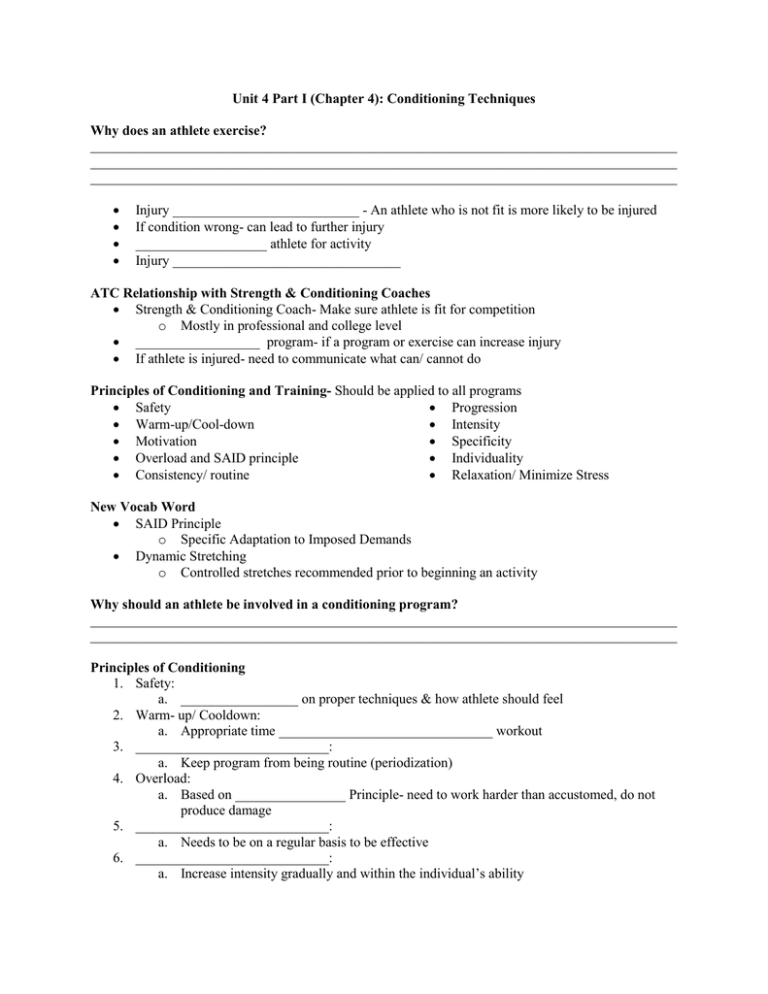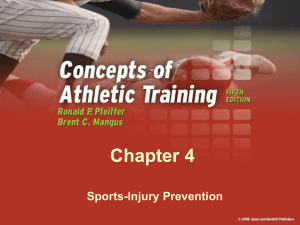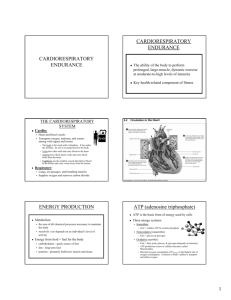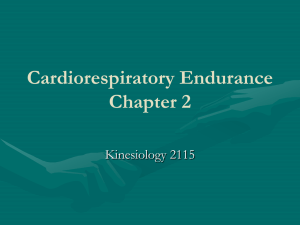Unit Four Part I Student Notes
advertisement

Unit 4 Part I (Chapter 4): Conditioning Techniques Why does an athlete exercise? _____________________________________________________________________________________ _____________________________________________________________________________________ _____________________________________________________________________________________ Injury ___________________________ - An athlete who is not fit is more likely to be injured If condition wrong- can lead to further injury ___________________ athlete for activity Injury _________________________________ ATC Relationship with Strength & Conditioning Coaches Strength & Conditioning Coach- Make sure athlete is fit for competition o Mostly in professional and college level __________________ program- if a program or exercise can increase injury If athlete is injured- need to communicate what can/ cannot do Principles of Conditioning and Training- Should be applied to all programs Safety Progression Warm-up/Cool-down Intensity Motivation Specificity Overload and SAID principle Individuality Consistency/ routine Relaxation/ Minimize Stress New Vocab Word SAID Principle o Specific Adaptation to Imposed Demands Dynamic Stretching o Controlled stretches recommended prior to beginning an activity Why should an athlete be involved in a conditioning program? _____________________________________________________________________________________ _____________________________________________________________________________________ Principles of Conditioning 1. Safety: a. _________________ on proper techniques & how athlete should feel 2. Warm- up/ Cooldown: a. Appropriate time _______________________________ workout 3. ____________________________: a. Keep program from being routine (periodization) 4. Overload: a. Based on ________________ Principle- need to work harder than accustomed, do not produce damage 5. ____________________________: a. Needs to be on a regular basis to be effective 6. ____________________________: a. Increase intensity gradually and within the individual’s ability 7. Intensity: a. _______________________________________ or workload, not duration (shorter workout, higher intensity) 8. Specificity: a. _______________________ to the program. Should be relative to the activity or sport 9. ___________________________________: a. Adjust team work out to the individual athlete (lineman vs. receiver, sprinter vs. distance) 10. _________________________________ Stress: a. Train as close to their limit but remembers stressors outside of sport (school, life, etc.) What are the 10 Principles of Conditioning? _____________________________________________________________________________________ _____________________________________________________________________________________ _____________________________________________________________________________________ Warm-Up Precaution against unnecessary musculoskeletal injury and soreness Function-_______________________ body for upcoming physical work Purpose- Gradually increase cardiorespiratory system & increase muscle temperature Start with ____________ minutes of light jogging, cycling etc. breaking into light sweat Flexibility exercises Once warmed-up need to begin activity within 15 minutes Dynamic Stretching Active warm-up Involves continuous movement (hopping, skipping, bounding, footwork, etc.) Enhances coordination and prepares muscles for sports specific activity May last ____________ minutes Cool-down Essential component of workout Bring body back to ____________________________ 5-10 minutes in duration Decreased muscle soreness following training if time used to stretch after workout New Vocab Word Cardiorespiratory Endurance o The ability to perform whole-body, large-muscle activities for extended periods of time Cardiorespiratory Endurance System’s _____________ components o Heart, Lungs, Blood vessels and Blood Improvements in endurance are the results of improvements in these 4 components Transport & Utilization of O2 (oxygen) Oxygen (O2)- is transported throughout body Greatest rate at which O2 can be taken in and used is Maximum Aerobic Capacity (VO2 max) The greater the rate or intensity of an activity the______________________ is needed VO2 Max (Max aerobic capacity) _____________________ certain range of maximum aerobic capacity o Can train to get to max Average value = 45-60 ml/kg/min Marathon Runner= 70- 80 ml/kg/min Find Your VO2 Max Lab Effects on the Heart The heart- the main pumping mechanism to get ________________________________________ As you exercise, muscles need more oxygen, thus heart will pump faster o Will adapt approx. 2-3 minutes into activity (at given workload) and will plateau Greater the intensity- greater the ________________________ Heart can also increase ___________________________o The amount of blood being pumped out with each beat Cardiac Output: Stroke volume plus (+) heart rate = the volume of blood being pumped at a certain time New Vocab Word Training Effect o Stroke volume increases while heart rate is reduced at a given exercise load Effect’s on Work Ability Cardiorespiratory endurance has critical role in ability to ______________________________ When comparing two people working at the same intensity, the individual with a higher VO 2 max will be working at a lower % of maximum aerobic capacity o Higher VO max = ability to sustain activity at a given intensity longer 2 QUESTIONS What are the 2 effects on the heart with increased cardiorespiratory endurance? o ________________________________________________________________________ o ________________________________________________________________________ Why do you think a better cardiorespiratory endurance gives an athlete a decreased chance of injury? o ________________________________________________________________________ Energy Systems ____________________________________ involves specific demands for energy o Sprinting/ Jumping- high energy in a short time o Long distance/ swimming- low energy over a long period of time o Most- blend of both ATP: Immediate Energy Source o ATP produced from ________________________breakdown (carbohydrates) o Glucose from blood or ____________________________ (stored in muscle or liver) broken down to glucose and converted to ATP o Fat becomes utilized when glycogen stores are depleted Longer duration of activity, the greater amount of fat is used FILL IN BLANK One uses _________________ for energy. It is broken down from _____________ (found in blood) or _____________ (found in muscle/ liver). ____________ is used during longer durations or when glycogen stores are depleted. Anaerobic Metabolism (without oxygen) During ___________________________________ of activity ATP is used (last few seconds) Body then uses glycogen, which is broken down to glucose then metabolized to ATP By-product is ______________________________ Cannot talk while exercising Aerobic Metabolism (with oxygen) Use of complex carbohydrates and fat to generate ATP (___________________________ to metabolize) Aerobic burns/ clear lactate acid but takes 20 minutes Much more efficient (gives you more energy per metabolism) Can talk while exercising QUESTION List 3 anaerobic sports o ________________________________________________________________________ List 3 aerobic sports o ________________________________________________________________________ Training Techniques for Improving Cardiorespiratory Endurance Level of improvement will be determined by initial levels Continuous Training Involves _____________ Considerations o Frequency o Intensity o Type of activity o Time Frequency: o No fewer than ____________ sessions per week, should aim for 4-5 o Should allow at least 1 day off per week for mental and physical rest Intensity: o Most ____________________ , particularly in early stages o Uses heart rate- find if pace is too hard or too slow Finding Your Intensity Target Heart Rate o Determine maximum heart rate (HRmax) Involves exercising at max levels and monitoring HR using an electrocardiogram Approximations can also be used as well 220-age = HRmax Heart Rate Reserve (HRR) o Difference between resting (HRrest) and HRmax Potential of heart rate training intensities HRR = HRmax – Hrrest Finding Your Heart Rate Reserve 1. What is your HRmax? a. 220- age = ____________ 2. Find your resting heart rate (HRrest). a. Find your pulse (brachial-wrist or carotid- neck) b. Take for 15 seconds, multiple by 4 c. _______________________ 3. What is your HRR? a. HRR = HRmax – HRrest b. _______________________ Calculate Exercise Heart Rate at a Given Training Intensity Karvonen Equation o Exercise Heart Rate = % of intensity (HRR) + HRrest o % of Intensity: Minimum is 60% Maximum is 85% (want average 70%) Find your target heart rate at 70% Use Karvonen Equation o Exercise or Target HR = % of target intensity (HRmax – HRrest) + HrRest X = .7 (answer to number 3) + answer to number 2 (Do multiplication first) X = .7 (________________) + _________________ X= _________________ + ___________________ X= _____________________________________ Your exercise heart rate for proper intensity. Continuous Training Type: o Must be _____________________ o Whole body, large muscle movement (jogging, walking, swimming, etc.) o Intermittent activities hard to monitor (basketball, tennis, etc.) Time: o At least 20 minutes at a continuous level (some studies show ____________ minutes) QUESTION For continuous training, give examples or durations for the 4 considerations o ______________________________________________________________________ New Vocab Word Interval Training o Alternating periods of work with active recovery Interval Training Must occur at ______________________% of maximal heart rate Active rest at 30- 45% maximal heart rate Most anaerobic sports require short burst (sports specific training- mimics sport) QUESTION Design an interval training workout for any sport. o ________________________________________________________________________ ________________________________________________________________________ Speed Play Athlete must run for a specific ________________________________, pace/ speed are not specified Similar to cross-country running- varied terrain Must elevate heart rate to minimal training levels Good for off-season conditioning or a change-up in sport Equipment for Cardiorespiratory Endurance Training Can vary from a $2 jump rope to machines that cost $10,000 Can use natural environment



